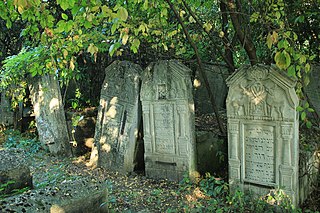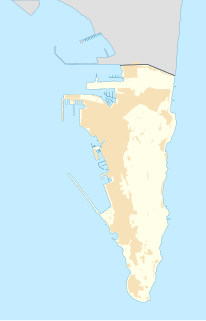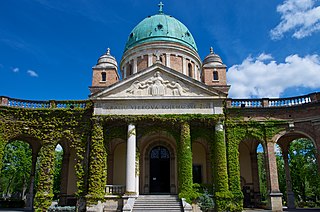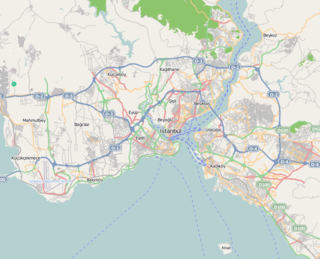 W
WA Jewish cemetery is a cemetery where Jews are buried in keeping with Jewish tradition. Cemeteries are referred to in several different ways in Hebrew, including beit kevarot, beit almin or beit olam [haba],, the beit chayyim and beit shalom.
 W
WBallybough Cemetery is a Jewish cemetery in Ballybough, Dublin. Founded in 1718, it is Ireland's oldest Jewish cemetery.
 W
WThe Jewish cemetery of Beirut, located close to Sodeco Square, is the only Jewish cemetery in the city. It is also accessible via the Damascus Road, also known as "Rue de Damas". Some of the gravestones were broken during the Lebanese civil war, but it remains a functional cemetery for Lebanon's Jewish population.
 W
WThe New Cemetery is a cemetery complex in Belgrade, Serbia, with a distinct history. It is located in Ruzveltova street in Zvezdara municipality. The cemetery was built in 1886 as the third Christian cemetery in Belgrade and as the first architecturally and urbanistically planned cemetery in Serbia.
 W
WThe Central Sofia Cemetery or the Orlandovtsi Cemetery ("Орландовци") is the main cemetery in Sofia, the capital of Bulgaria. The cemetery has several chapels used by various Christian denominations, such as a Bulgarian Orthodox church of the Dormition of the Theotokos, a Roman Catholic chapel of Saint Francis of Assisi, an Armenian Apostolic chapel, a Jewish synagogue, etc. The cemetery also features Russian, Serbian, Romanian and British military sections.
 W
WChatam Sofer Memorial, formerly the Old Jewish Cemetery is the burial place and memorial of Moses Sofer a prominent orthodox rabbi from the 19th century built at the place of a 17th-century Jewish cemetery in Bratislava, Slovakia. The historical cemetery was mostly destroyed with the construction of the road tunnel under Bratislava Castle in 1943 but negotiations with the clero-fascist Slovak leader Jozef Tiso allowed an important fraction of the cemetery containing the graves of the rabbis to be preserved encased in concrete. Later, when the tunnel was converted for public transport trams a tram stop was constructed above the site. In 2002 a modern memorial was erected above the site and it was partially opened to the public.
 W
WThe Jewish Cemetery of Coro is the oldest Jewish cemetery in continuous use in the Americas.
 W
WDardasht is a central neighbourhood of Isfahan, Iran. Formerly known as Babol-Dasht, it is known for its historical minarets, cemetery, the Darb-i Imam Shrine, dated to 1453/857 AH and the Harun-i Vilayat Mausoleum. The Dardasht quarter of Isfahan was one of the major Jewish quarters of the city.
 W
WThe Southern Cemetery in the New Zealand city of Dunedin was the first major cemetery to be opened in the city. The cemetery was opened in 1858, ten years after the founding of the city in an area known as Little Paisley. This area lies at the southern end of Princes Street, one of the city's main streets, close to the suburbs of Kensington, Maryhill, and The Glen.
 W
WThe old Jewish cemetery in Hebron, is located to the west of the Tomb of Machpela on a hill and has been used as a Jewish cemetery for hundreds of years, as attested to by Ishtori Haparchi, who noted a Jewish cemetery in the area in 1322. Other sources indicate the cemetery being mentioned in a letter dated to 1290.
 W
WThe Jewish Catacombs of Venosa are a set of catacombs located near the Italian city of Venosa, Province of Potenza, on Maddelena Hill. The exact date of construction for the catacombs is unknown, but it seems likely that they were built and used between the 4th and 6th centuries CE, and their existence has been known since the 19th century. The structure of the catacombs is simple, with two parallel tunnels connected by passages.
 W
WThe Jewish Cemetery is located off Lloyd's Road in Chennai, India. The cemetery remains the only memoir of the once significant Jewish population of Chennai, which has now almost become extinct. Burials include the tombstones of 18th-century Jewish diamond merchants. The cemetery houses less than 30 graves, of which a few are over 300 years old. The cemetery is located on a poor market area of the road west of the Marina Fish Market and is adjacent to Baháʼí Faith and Chinese cemeteries. The cemetery formerly used to have an iron gate on which a plaque was attached on which a Star of David and the words "Jewish Cemetery" were inscribed. After the renovation around 2016, these doors were replaced with sturdier ones. Before the renovation, the cemetery had been reported to be in a state of severe disrepair – with rusted iron gates, partially grown shrubs ,and cracked walls. People in the surrounding area were oblivious to the existence and historical importance of the cemetery. Even now, it tends to have few visitors.
 W
WThe Jewish cemetery of Briceni is located in the eastern vicinities of Briceni in northern Moldova, near the Ukrainian border. It is situated north of road R11, which leads to Ocnița.
 W
WThe Miâara Cemetery is the Jewish Cemetery of the city of Marrakesh, Morocco. It is the largest Jewish cemetery in the country.
 W
WThe Jewish cemetery of Salonica was established in the late fifteenth century by Sephardic Jews fleeing the expulsion of Jews from Spain, covered around 350,000 square metres (3,800,000 sq ft) and contained almost 500,000 burials. The cemetery's expropriation was envisioned in the urban redevelopment plan following the 1917 Great Fire of Thessaloniki, but strongly opposed by the Jewish community as disturbing the graves violated Jewish law. The cemetery was finally destroyed in December 1942 by the municipality of Thessaloniki as part of the Holocaust in Greece during the Axis occupation of Greece. The headstones were used as building materials around the city, including for Greek Orthodox churches, while the Aristotle University of Thessaloniki was built on the grounds. The Jewish community never received compensation for the expropriation of the land, valued at 1.5 billion drachmas in 1943.
 W
WThe Jewish Cemetery is a cemetery in Marsa, Malta. It was established in December 1879, and it was built to designs of the English architect Webster Paulson.
 W
WThe Jewish Northern Cemetery in Nørrebro was formerly the principal Jewish cemetery in Copenhagen, Denmark. It has an area of 13,500 square metres and contains some 5,500 burials.
 W
WJews' Gate Cemetery is a Jewish cemetery located on Windmill Hill within a nature reserve in the British Overseas Territory of Gibraltar. Also known as the Windmill Hill Cemetery, it is the site of the earliest known Jewish burials in Gibraltar. The cemetery opened by 1746 and closed in 1848. It is the burial site of a number of Gibraltar's Chief Rabbis. The graveyard is protected by the law of Gibraltar.
 W
WThe Mirogoj City Cemetery, also known as Mirogoj Cemetery, is a cemetery park that is considered to be among the more noteworthy landmarks in the city of Zagreb. The cemetery inters members of all religious groups: Catholic, Orthodox, Muslim, Jewish, Protestant, Latter Day Saints; irreligious graves can all be found. In the arcades are the last resting places of many famous Croats.
 W
WMosaisk Vestre Begravelsesplads is a Jewish cemetery in Copenhagen.
 W
WOhel is a structure built around a Jewish grave as a sign of prominence of the deceased. Ohelim cover the graves of some Hasidic Rebbes, important rabbis, tzadikim, prominent Jewish community leaders, and biblical figures. Typically a small masonry building, an ohel may include room for visitors to pray, meditate, and light candles in honor of the deceased.
 W
WThe OId Jewish Cemetery is a cemetery in Sarajevo, Bosnia and Herzegovina. It is located on the slopes of Trebević mountain, in the Kovačići-Debelo Brdo area, in the south-western part of the city. It is the largest Jewish cemetery in Southeast Europe. It was in use for approximately four hundred years from the beginning of the 16th or 17th century until 1966.
 W
WPir Bakran is a city and capital of Pir Bakran District, in Falavarjan County, Isfahan Province, Iran. At the 2006 census, its population was 10,851, in 2,934 families. It is located southwest by road from Isfahan.
 W
WThe Ulus Ashkenazi Jewish Cemetery is a burial ground of the Ashkenazi Jewish community in Istanbul, Turkey. However, it is also used today for Sephardi burials due to overpopulation of the nearby Ulus Sephardi Jewish Cemetery, which is about 500 m (1,600 ft) north of the Ashkenazi Jewish Cemetery on the same street.
 W
WThe Ulus Sephardi Jewish Cemetery or Arnavutköy Jewish Cemetery is a burial ground of the Sephardi Jewish community in Istanbul, Turkey. It was established in 1901 during the Ottoman Empire era in Arnavutköy neighborhood of Beşiktaş district on the city's European side.
 W
WZemun Cemetery is a public cemetery situated in Zemun on the Gardoš Hill. It is bounded by Cara Dušana Street, Nade Dimić Street, Sibinjanin Janka Street and Grobljanska Street, as well as with the staircase towards the Branka Radičevića Square, thus making the northwest boundary of the Old Core of Zemun. The cemetery is proclaimed the cultural monument.